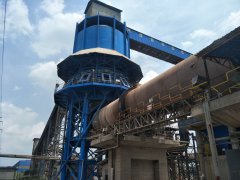The lime vertical kiln calcination process is a traditional lime production process that uses limestone as raw material and calcines it into lime at high temperatures. The process can be divided into the following steps:
Raw material preparation: High-quality limestone is selected as the raw material, which is crushed into small pieces and impurities and soil are removed.
Kiln construction: Bricks or stones are assembled into a vertical kiln of a certain shape and size, with a windbox at the bottom for gas entry.
Charging: The raw material is fed into the kiln through the kiln mouth, taking care not to add too much to avoid affecting the quality of the calcination.
Ignition: The gas at the bottom of the kiln is ignited to burn, and heat is transferred to the inside of the kiln.
Calcination: At high temperatures, the limestone gradually decomposes, releasing carbon dioxide and forming quicklime.
Discharging: After a period of calcination, the quicklime will drop from the top of the kiln to the kiln mouth and become the finished lime.
Cooling and dismantling: After the calcination is completed, the gas is extinguished, and the kiln body is allowed to cool before being dismantled. The finished lime is collected and packaged.
The advantages of the lime vertical kiln calcination process are simple production technology, low investment, and good product quality, but the disadvantages are high energy consumption, low production efficiency, and poor environmental performance. In recent years, with the progress of technology and the increasing awareness of environmental protection, lime production has developed towards energy-saving, environmental protection, and high efficiency, gradually replacing the lime vertical kiln calcination process.



